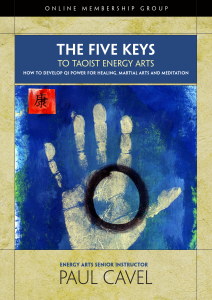
One of the most satisfying things about running this site is when you guys reach out and ask questions about Qigong and Tai Chi.
Today, I wanted to share with you 3 of the most common ones I get about starting up a qigong practice (and if you have a different one, something I've missed, let me hear about it!). Hopefully, these questions will line up with something you've been thinking about in your practice too (again, let me know in the comments!).
So, in no particular order, here we go:
Fitting the Puzzle Pieces Together
The first question is some version of, "I read forums online, own several Tai Chi and qigong books, and watch YouTube clips and DVDs to learn more about my practice, but I'm not quite sure how to pull it all together."
Even though there is more and more information available for all of us, you still need a way to organize it so that you know you have a well-rounded approach to your practice.
For qigong, this means touching on:
- Breathing that relaxes the nervous system
- Energy Work to increase circulation through your channels and meridians
- Physical Movements that loosen up the joints and soft tissues to amplify the energetic flows
- Stillness Practices that develop your "inner senses"
Notice how I didn't mention any particular "set" or "form?"
I don't care how many sets you know or how many forms you do and when....what really matters is whether you are touching on all these areas.
For each part of your practice, how many elements of that list does it touch? Are there any big gaps in your current routine?
Of course, everyone is going to have a favorite practice (if you've been reading here for a while, you know mine is standing qigong.) and it will be central to everything else you do. But when you rub your practice up against this checklist, you'll see to what degree even your favorite thing will have these components...and that will open you up to new and creative ways to grow your practice.
Returning to Younger Days
The next question goes something like, "I studied Tai Chi years ago, briefly in college, and now I want to start again, but I can't find a good class."
Sometimes that's followed by frustration that your 20-year-old self didn't know what a great learning opportunity you had at the time. Oh well!
If you want to recapture how good and relaxing it felt to do Tai Chi or qigong back then, now you need a step-by-step approach to learning that will bring you back into a nourishing energetic space. It's not enough to try to remember the old moves you used to do.
And if you look at the list from the first question, you might now understand why it was frustrating to go out and find a class near you. Maybe you stumbled across an instructor who had one or two of the things on that list, but didn't teach or didn't know how to access the full range.
You might be in the same boat as the first question, having to pull together different sources. You're not alone. I talk to many, many people who get certain dimensions of a whole qigong practice from different classes, their own personal practice, and past experiences.....but you might still be asking the question, "how do I pull it all together in a step-by-step approach following an authentic pathway?"
Before we answer that, let's look at the third question.
Filling in the Missing Pieces
The final question goes something like, "I'm pretty active and I want to figure out how to add qigong into my other fitness/wellness routines. What should I do?"
To answer this question, let's look at the list again, and apply it to your other activities. In other words, do you walk/run/lift/golf with these goals in mind?
- Breathing that relaxes the nervous system
- Energy Work to increase circulation through your channels and meridians
- Physical Movements that loosen up the joints and soft tissues to amplify the energetic flows
- Stillness Practices that develop your "inner senses"
Many people find that once they start a qigong practice, there is an inevitable shift towards awareness, relaxation and integration in the other things they do.
You notice how much you are panting and straining at peak effort and begin to shed excess tension. Or you figure out that your sore shoulder really comes from closed-down hips. Or at the end of your run, once you've stretched and you're body is cooling down, you can do 5 minutes of standing qigong to increase the feeling of settling your mind.
Training with a qigong mindset can help you find more looseness, relaxation, and flow in just about any activity.
And instead of learning long, complicated sets, people in this group understand quickly that short, focused-practice on core elements of qigong will greatly enhance your existing routines. You've found the missing pieces!
Creating A Whole Qigong Practice
Now, the 3 questions above often come from beginners, but the truth is, the quest for a whole, integrated practice is ongoing.
To one degree or another, we've all asked versions of these questions at different stages in our practice.
In the past, we've discussed them here:
- Are You Making Progress in Your Practice?
- The Struggle for Perfect Practice
- 9 Different Ways to Think About Tai Chi
- How Neigong Builds a Foundation for Meditation
How do you think about ongoing integration and wholeness in your own practice? How does your list of "complete practice" stack up to the one here? Let me know!
 Paul Cavel's new online course includes all the fundamentals of a great qigong program: Breathing, Energy Work, Standing Meditation, and Smooth Circular Movement.
Paul Cavel's new online course includes all the fundamentals of a great qigong program: Breathing, Energy Work, Standing Meditation, and Smooth Circular Movement.
UPDATE: I found out this week that for a limited time, Energy Arts and Senior Instructor Paul Cavel are opening an online course that lines up exactly with the issues we've been discussing here. Check it out: The Five Keys to Taoist Energy Arts.
As you know from many episodes of Qigong Radio, I turn to Paul whenever I want a clear and structured explanation of a dimension of my practice (check out these episodes on body development and meditation).
Now, he's basically gone ahead and answered the 3 questions in this post, by bringing together foundational practices that help you build every dimension of a complete qigong practice -- pretty much all of which you can practice in 15-20 minute sessions.
I've checked out the first couple of lessons and I can tell you that they are excellent -- straightforward, deep, and focused -- like we always expect from Paul.
The best part of this online course format is that Paul will be available to answer questions in a private forum for the training group (which is why it's only open for a limited time -- so that everyone can start and be on the same lessons together).
So, if you've been waiting for a chance to get started with qigong, no matter where you live or what background you bring to the practice, don't miss this opportunity.
And for experienced practitioners, Paul's clarity of teaching is sure to be an excellent upgrade. I'll see you inside the forums!

Share this post
Twitter
Google+
Facebook
Reddit
LinkedIn
StumbleUpon
Pinterest
Email